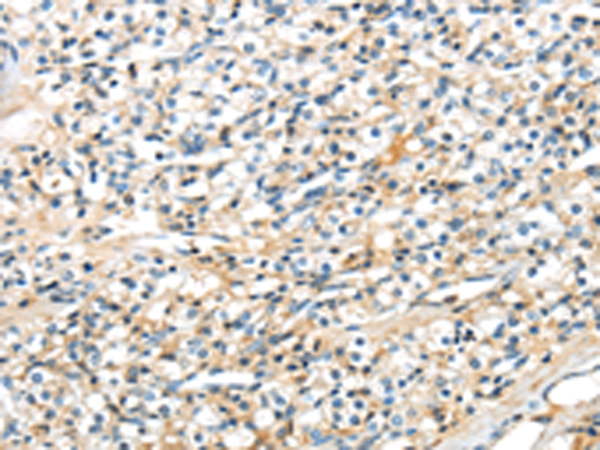

| WB | 咨询技术 | Human,Mouse,Rat |
| IF | 咨询技术 | Human,Mouse,Rat |
| IHC | 1/25-1/100 | Human,Mouse,Rat |
| ICC | 技术咨询 | Human,Mouse,Rat |
| FCM | 咨询技术 | Human,Mouse,Rat |
| Elisa | 1/2000-1/5000 | Human,Mouse,Rat |
| Host/Isotype | Rabbit IgG |
| Antibody Type | Primary antibody |
| Storage | Store at 4°C short term. Aliquot and store at -20°C long term. Avoid freeze/thaw cycles. |
| Species Reactivity | Human |
| Immunogen | Synthetic peptide of human TSPYL6 |
| Formulation | Purified antibody in PBS with 0.05% sodium azide and 50% glycerol. |
+ +
以下是关于TSPYL6抗体的3篇参考文献及其简要摘要:
1. **"TSPYL6 suppresses cell proliferation and induces apoptosis in colorectal cancer by regulating p53 signaling"**
- **作者**: Zhang Y, et al. (2020)
- **摘要**: 研究通过免疫组化(使用TSPYL6抗体)发现,TSPYL6在结直肠癌组织中低表达,并通过调控p53通路抑制肿瘤细胞增殖、促进凋亡。
2. **"TSPYL6 as a novel biomarker for ovarian cancer: immunohistochemical analysis and clinical correlation"**
- **作者**: Liu X, et al. (2019)
- **摘要**: 利用TSPYL6抗体检测卵巢癌组织样本,发现其表达与患者生存率显著相关,提示其作为预后标志物的潜力。
3. **"The role of TSPYL6 in hepatocellular carcinoma progression and its interaction with HIF-1α"**
- **作者**: Wang L, et al. (2021)
- **摘要**: 通过Western blot和免疫荧光(基于TSPYL6抗体)证实,TSPYL6通过抑制HIF-1α通路降低肝癌细胞的侵袭和转移能力。
如需具体文献原文,建议通过PubMed或Google Scholar检索DOI编号获取全文。
The TSPYL6 antibody is a tool used to detect the TSPYL6 protein, encoded by the TSPYL6 gene, which belongs to the testis-specific Y-encoded-like (TSPYL) family. This family shares homology with the TSPY (testis-specific protein Y-encoded) gene and is involved in cell cycle regulation and carcinogenesis. TSPYL6. located on chromosome 2q14.1. is expressed in various tissues, including the brain, testis, and ovaries, and plays roles in cellular differentiation, apoptosis, and chromatin remodeling. Dysregulation of TSPYL6 has been implicated in cancers, such as hepatocellular carcinoma and prostate cancer, where it may act as a tumor suppressor by modulating p53 activity or interacting with cell cycle inhibitors.
The TSPYL6 antibody is commonly utilized in research to study protein expression patterns, subcellular localization (primarily nuclear), and functional mechanisms in both normal and pathological states. It is validated for applications like Western blotting, immunohistochemistry, and immunofluorescence. Studies using this antibody have explored TSPYL6's role in oxidative stress responses, DNA damage repair, and its potential as a biomarker for cancer prognosis. Researchers also investigate its interaction with epigenetic modifiers, such as histone deacetylases, to understand its impact on gene silencing and chromatin dynamics. The antibody's specificity is often confirmed via knockout controls or siRNA-mediated silencing, ensuring reliable detection in experimental models.
×